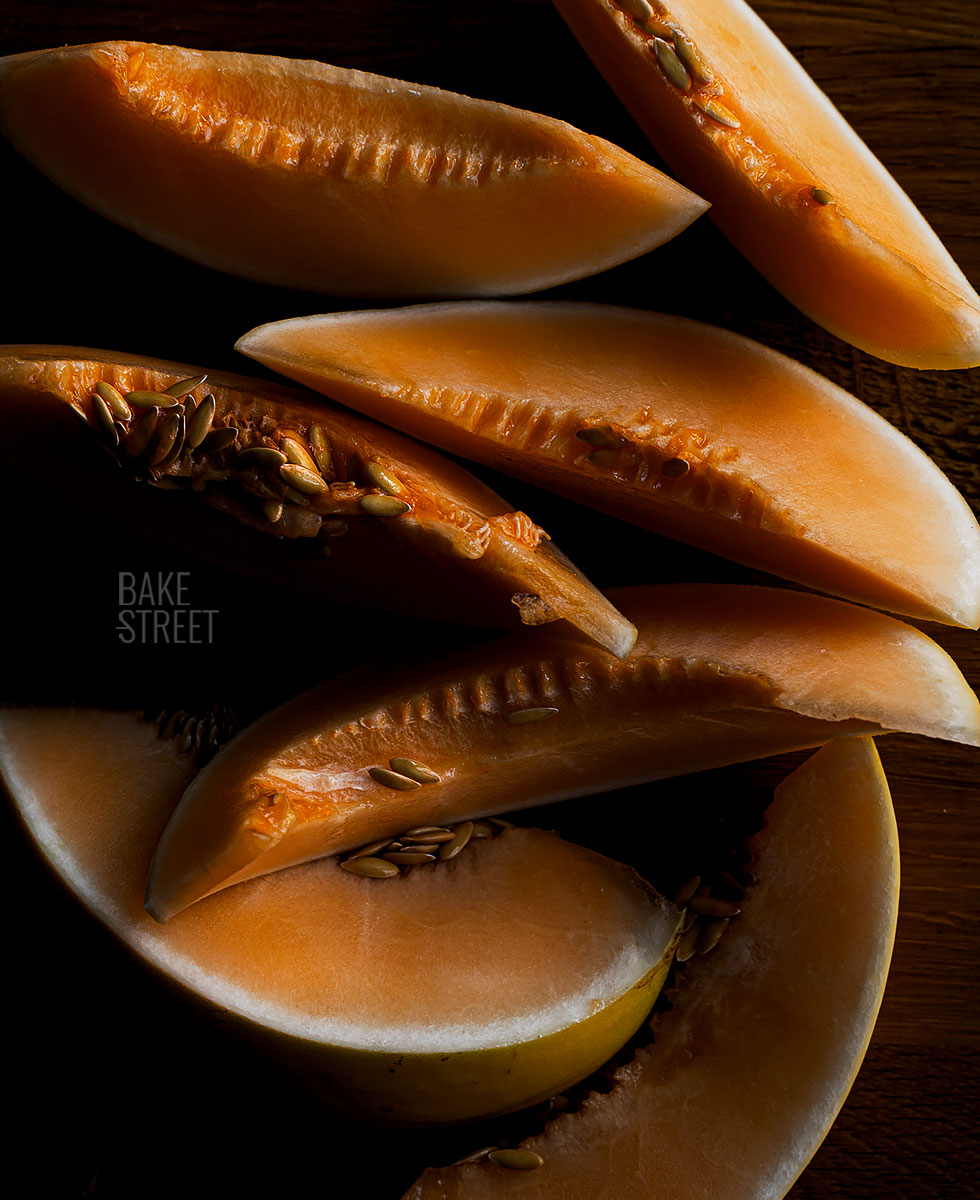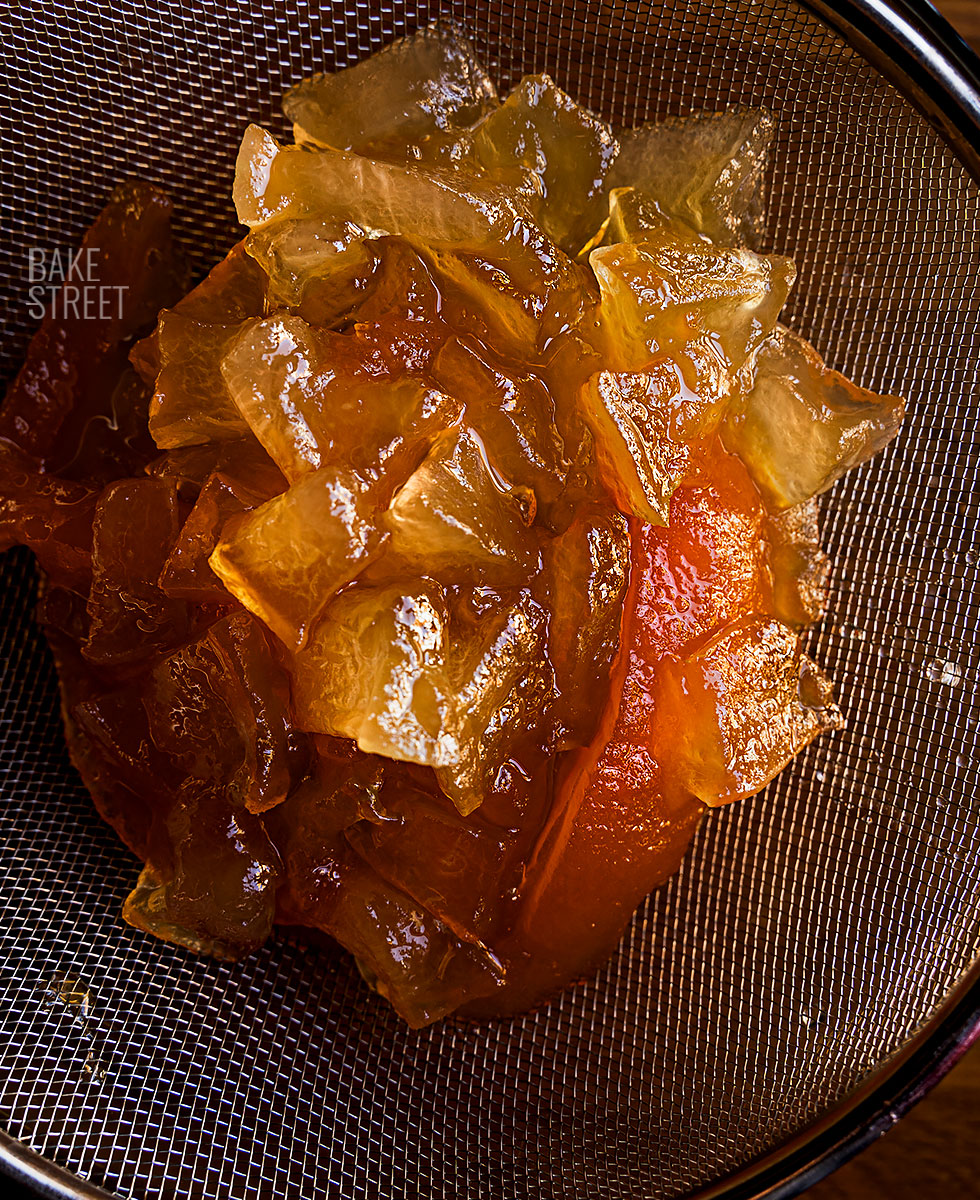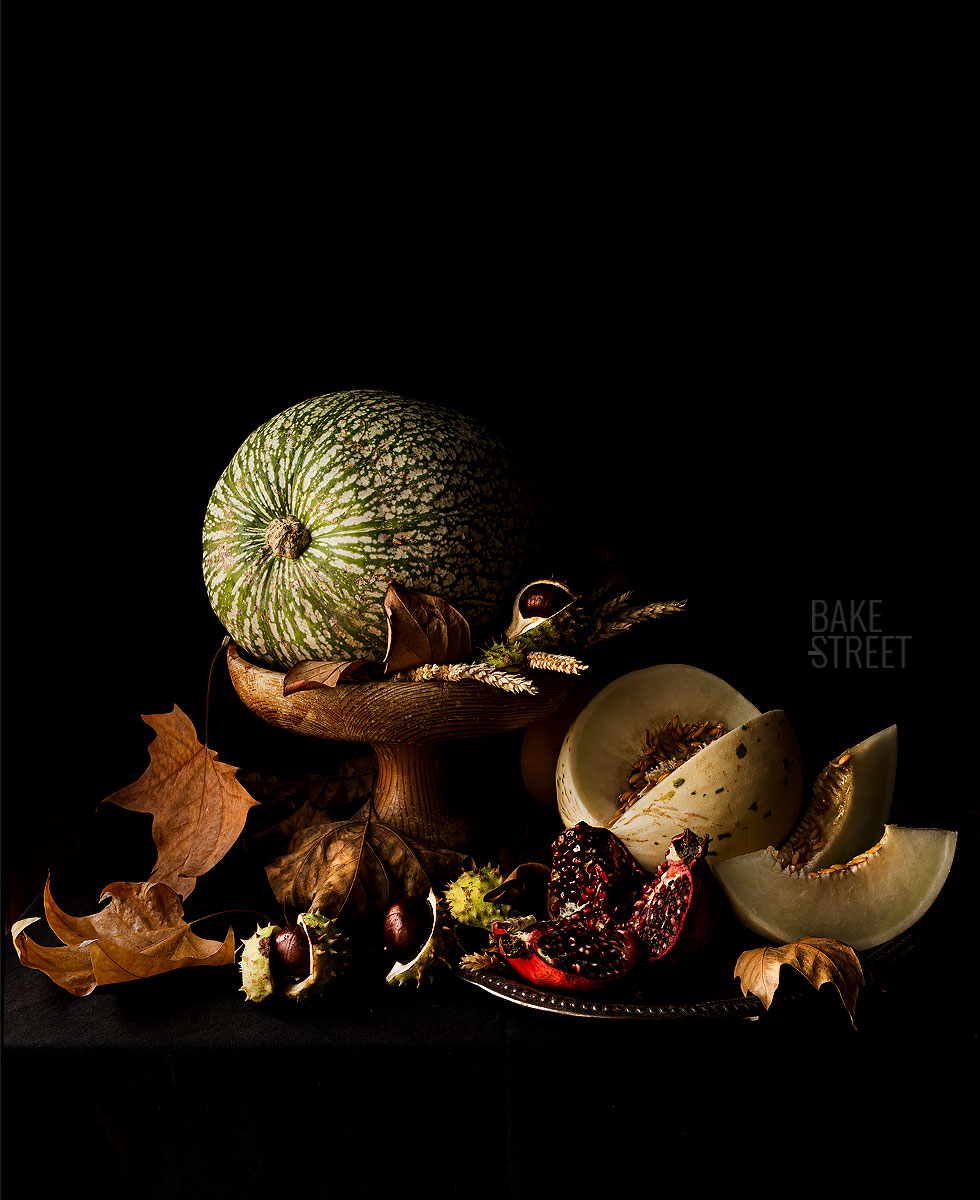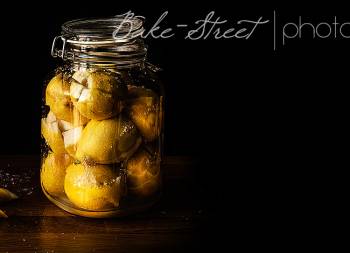
How to make candied melon
I have a lot of recipes accumulated that I have been preparing during these last months, but due to lack of time (my courses) I have not been able to publish them yet. Like this Candied melon recipe that I prepared during the summer and I couldn’t wait to share it with you. I have always wanted to make this recipe for the blog for several reasons; It is incredibly spectacular, very versatile and not always easy to find.
I’m not going to lie, it’s a long process. There are many days in which we will have to be patient, but with minimal effort and work. The only thing you have to do is to know that in your kitchen there will be a big pot for 14 days (not like in the case of the Marron Glacés, there is a lot of entertainment there). Apart from that, really easy to make, promise!
Candied fruit origin.
It could be said that candied fruits are the predecessors of today’s sweet treats, which originated more than a millennium ago and gained their popularity thanks to the medieval Italians (or so it is believed).
Nostradamus was one of the most influential, enthusiastic and consuming people of the time and described it as an absolute delicacy.
Candied fruit is, by definition, the process of covering fruits with a sugar bath to make them more palatable. To elaborate them, they must be boiled in a sugar syrup, in which the sugar concentration will be progressively increased, which will favor the saturation of the sugar inside, replacing the water. This process allows candied fruits to be preserved for long periods of time.
To candy fruits, we must select the pieces very well. Fruits with firm flesh behave much better during this process than ripe fruits or those with looser flesh. In the latter case, it is very easy for them to lose their shape and even their structure, since they will not support the sugar load well.
Another benefit of sugar candying is that it prevents the growth of microorganisms, so it is also used as a natural preservative.

In the beginning, the candying process was carried out in special heated vats.
It lasted two weeks, during which it was important to monitor the temperature and concentration of the sugar syrup. Since sugar was a very expensive ingredient, candied fruits were considered a luxury that could only be enjoyed by royalty and aristocrats.
The verb to candy, which translates as; To sweeten or Preserve (fruits, etc.) by a process in which ingredients are boiled with sugar, which crystallizes and forms a coating; to cover or coat with sugar.
The Venetians took over the sugar trade, as they did everything lucrative, and planted sugar cane in Crete (hence the sweet sugar in the island’s ancient name, Candia) and in Sicily. But the main producer in the Mediterranean basin remained Egypt. Nevertheless, sugar remained a very expensive luxury product that could only be enjoyed by the nobility.
The process of candying dates back to the ancient inhabitants of Mesopotamia, China, Egypt and the Roman Empire.
In the Roman Empire 453 B.C., candied fruits were already prepared, bathed in honey, this technique helped to preserve fruits for a longer period of time. In the 16th century Nostradamus wrote a ‘Traité des fardements et confitures‘ where he talked about how to preserve quinces and citrus fruits.
The origin of this technique was driven by the purpose of extending the shelf life of fresh food. In hot climates, fruit undergoes rapid ripening, making storage and transport to distant places a difficult task. For this reason, they began to preserve them in honey, resulting in a practical solution to this problem.
Honey is composed mainly of simple sugars, something that allows us to eat any fruit preserved in it without risk. It remained in perfect condition for months or even years, regardless of the outside temperature.
Musical break.
Many times, when I prepare, cook, photograph or write some recipes, they transport me (according to their history) to certain moments of our evolution. This recipe takes me to far away places, where the most sophisticated and privileged thing was to listen to music in the great halls of the aristocracy, theaters or private shows. I imagine those moments where things were valued differently, as well as experiences.
This song, despite being a bit sad (but just as beautiful), transports me to that. Those years when we still had a lot to evolve and improve. Like now, but in another era.
The first pastry shop was founded in Venice in the year 1150.
From this time European artisans developed the technique of working with sugar and, at the beginning of the 13th century, several places in Italy evolved the production of sweets on a large scale. The first products sold were mainly candied fruits. It is for this reason that confectionery is believed to have been invented in Italy. This fact is still believed to this day, as Italy is still the queen of the confectionery industry.
The Italians considered the technique of working with sugar to be very important. As proof of its dominant role, in the year 1343, Pope Clement VI granted the bishop the title of Master of Confectionery Products. This distinction made the city a privileged place for the production of candied fruits.
At that time, candied fruits imported from Arab countries were mostly citrus fruits: oranges, lemons, limes and tamarinds.
At the beginning of the confectionery profession in Europe, the patisseursconfit the same fruits they knew, but they soon realized that the same process could be carried out with local products. That is where they began to confit their fruits and even flowers.
These pieces of confectionery were ideal for consumption during the winter, when it was not possible to purchase or preserve fresh fruits. The first evidence of candied fruits, after citrus fruits, were plums and apricots.
One of the first descriptions of candied fruits is found in the Llibre de Totes Maneres de Confits (Book of All Ways of Making Sweets), a 14th century anonymous treatise on the art of confectionery written in Valencian. It could be considered the first dessert recipe book written in a Romance language. Its style is somewhat coarse and does not stand out for its literary quality, but it is probably the oldest book of this genre in Europe written in a language other than Latin.
It contains 33 recipes for desserts made with honey and sugar; candied fruits, jams, compotes and nougat. Among the ingredients used one can find: watermelon, lemon, almond, quince, turnip, parsnip, carrot, peach, apple, pear, walnut and cherry.
Later, fruit preserves appeared and were mentioned in the Treasury of Men’s Pores, another anonymous work published in 1526. Later appears the text of Thomas Elyot with Castel de Helth, published in 1541, where he describes; “Gynger condite, the whiche do call grene gynger, specyallye candyd with sugar” – candied ginger as a remedy for an excess of phlegm.

Nostradamus and his Treatise on Jams: Book of recipes for jams and magic potions.
Michel de Nôtre-Dame, better known as Nostradamus, is famous mainly for the publication of his collection of prophecies entitled Les Prophéties.
But, most likely, he is not so well known for having worked as an apothecary, in addition to having studied medicine. It is even more curious that the cookbook he wrote contains recipes for both magic potions and jams. A very interesting mix indeed, although it is always possible to fall in love through food, isn’t it?
Thanks to his experience as an apothecary, Nostradamus was able to write a book titled Traité des fardements et confitures, which can be translated as Treatise on beauty and jams.
It was published in the year 1552 in Lyon, possibly by Antoine Volant and printed by Jean Pullon de Trin as suggested in later editions. The preface, dated April 1, 1552;
“I came to complete my study to the present time, which is the thirty-first year of my vacation, which we have one thousand five hundred and fifty-two.” (Volant ed., 1555, p. 4).
Jeremias Mertz (Martius), the German translator of the TFC in 1572, notes that Nostradamus first printed this book in 1552 for his friends.
“If anyone has the perfect intelligence to possess the mastery of governing sugar well and properly, he will turn all fruits into perfect jams and, on the contrary, if he does not know well the effect of sugar when it is liquid, he will bring everything to perdition”, Nostradamus.
Pierre-Joseph de Haitze indicates the publication of a “Treatise on ornaments and aromas” in 1552, confirmed by Falconet’s catalog, which mentions the city of publication, the year and the format of this first edition: The true and perfect embellishment of the Face and the way to make jams (Lyon, 1552, in-12). Eugène Bareste, first bibliographer of Nostradamus, indicates a copy that has disappeared from a catalog of the Royal Library ( call number : T 3815), under the title: Vray et parfaict embellissement de la face (sl, 1552, in-8) .
This is probably the same edition, although it is not excluded that there already existed, as early as 1552, two editions or two copies of the TFC, of which no copy has survived.
The writer praises the candied fruits of Spain and Italy, especially those of the cities of Valencia, Genoa and Venice, which were already sold in France. In his recipes for sweets one could perceive the influence of the Hispano-Arabic tradition, as well as that of his Jewish ancestors, from the tribe of Issachar.
In the treatise he bequeaths us a recipe for marzipan, called faludaj. He relates it to Hermolaus Barbarus(1410-1471) who called it “martial bread” and tells us that it even serves as medicine, because of how good it feels.
He also reveals the secret of “candy sugar“, whose name comes from Baluchistan, where in the 10th and 11th centuries a chewing sugar called khayendiwas produced, a name that evolved into “candy sugar” (hence the English word candy for “confection”).
The rose is used in both syrups and jams, which require up to 1,500 flowers.
Nostradamus does not ask for just any roses, but for those of marvelous perfume, “like those of Arabia, of Isfahan or of the Valley of the Roses of Bulgaria“.
Moreover, he warns;
“If you want your jam to contain all the alchemical essence of the rose, you must pick them in the morning, before sunrise, when they are still pearly with dew, raw material for the search of the Philosopher’s Stone or potable gold”.
Banquets that took place in the opulence of the European courts were documented by Renaissance chefs in their books.
Cristoforo da Messisbugo in Banchetti, Composizioni di Vivande e Apparecchio Generale of 1549, as well as Bartolomeo Scappi with Opera dell Arte del Cucinare of 1570. Fruits such as lemons, oranges, pomegranates and chestnuts were considered more than just sugar-coated nuts.
They could be used to make more advanced products that preceded today’s nougat. Candied fruits were considered a divine gift, as well as being attributed with the power to close the stomach and facilitate digestion.
As time went by, more cookbooks appeared showing the art of candied fruit, as well as other cooking and baking techniques. This made it a fashionable hobby for housewives in the mid-18th century. This made this skill an indispensable ability for a young woman to possess.

Candied melon recipe
- 1.300 g of clean melon, without peel and seeds
- 2 kg sugar
- 1 liter water
- 10 g freshly squeezed lemon juice
MATERIAL WE WILL NEED:
- large pot
- digital cooking thermometer
- strainer + bowl
- food dehydrator
Instructions
FIRST DAY (ideally in the evening)
Clean melon.
- Cut the melon into slices, remove the peel and seeds.
- Cut into pieces, not thin, but rather thick pieces because with the process of candied melon will be greatly reduced since it loses a lot of water. If desired, we can cut into slices without chopping.
- Arrange in a large bowl.
- Once we have all the melon cut and weighed, prepare the syrup.
Prepare the syrup and add melon.
- In a large saucepan, add the sugar and water.
- Place over medium high heat and bring to a gentle boil. At this point the sugar will have dissolved completely.
- Turn off the heat and place the melon into the syrup.
- Melon will float, so we will have to place a lid (in my case plastic) with a smaller diameter than the pot to help the melon to be submerged. We can use another utensil as a weight, even gauze, to carry out this step.
- Let stand overnight in the syrup.

SECOND DAY (after 8-12 hours)
Heat again syrup.
- With the help of a slotted spoon, remove all the melon from the pot and place in a large bowl. We will notice that the melon has lost water and, therefore, volume.
- Place the syrup over medium-high heat and bring to a gentle boil.
- Once at this point, leave it for 5 minutes to allow some of the water released by the melon to evaporate.
- Turn off the heat and put the melon back into the syrup. Cover with the lid, or utensil of your choice, to keep all the pieces submerged and let stand for 12 hours.
Repeat the process to prepare the melon confit.
- After 12 hours, repeat the same process as in the morning.
- Remove the melon with a slotted spoon, heat the syrup until it comes to a gentle boil and leave it, this time, over medium-low heat for 2-3 minutes.
- Turn off the heat, place the melon in the syrup, cover and let stand for approximately 12 hours.

THIRD AND CONSEQUENTIAL DAYS (total of 14 days)
Heat the syrup and add the melon.
- From the third day, we will repeat the same process for 11 more days. That is, in total, the candying process lasts 14 days. The difference with the rest of the days is that we will only do the process once and let it rest in the syrup for 24 hours.
- With the help of a slotted spoon, remove all the melon from the pot and place in a large bowl.
- Place the syrup over medium heat and bring to a gentle boil.
- Once it comes to a boil, reduce to medium-low heat and turn off directly. From this point on, we do not let it cook at medium low heat for 2-3 minutes.
- Turn off the heat and introduce the melon in the syrup. Cover with a lid, or utensil of your choice, to help keep all the pieces submerged and let stand for 24 hours.
- On the last day of candying, once the melon is removed and the syrup is ready to be heated, add the lemon juice. Follow the same process as on the previous days; remove the melon, add the lemon juice to the syrup, place over medium heat until it comes to a gentle boil, turn off the heat and add the melon to the syrup. Cover and let stand for the last 24 hours.
- After the whole candying process, the melon will become transparent.
- NOTE: For those of you who like to know and know the brix degrees at which we have to elaborate it, it should be around 163º-165º/73º-75º. I will talk about this in a more extended way soon.
Prepare candied melon for drying.
- Remove the melon from the syrup with the help of a skimmer.
- Place on a colander, this will be placed over a bowl, and let it drain for 2 - 2 1/2 hours to remove all the excess syrup.
- Place the melon pieces on portions of greaseproof paper and place them on the dehydrator trays.
- Place at 158ºF/70ºC and dry for approximately 12 hours. The melon pieces should be dry to the touch, but slightly juicy inside.
- During the drying process, I advise you to move the trays up and down, as well as to check the drying point of the candied melon, as it may vary from case to case.
- Store in an airtight container.

Notes
- I have used three types of melon, piel de sapo, Galia and white melon. We need pieces that are not too ripe, that have firm flesh, but are not green so that they provide flavor and aroma.
- Since this fruit contains a high percentage of water, I recommend cutting the melon into large pieces or even slices. That way, when it is candied, we will not have very small pieces or with little volume.
- Normally, when we confit fruits, we add sugar progressively over the days. Since this fruit releases a lot of water, we will concentrate all the sugar at the beginning to cook it for several days.
- We should not cook the melon in the syrup, otherwise we can break its structure and obtain a puree. We must cook the syrup until it reaches a soft boil, at that moment we turn off the heat and introduce the fruit to let it stand for the specified time.
- The processing time of the melon confit may be slightly less than specified. We will know it is ready when it is completely transparent.

- If we want to give color to the melon confit, we can add food coloring to the syrup.
- To keep candied melon for a long time in an airtight container, we must dehydrate it. If we want it as is, we can store it in a glass container or Fido type jar with its own syrup. Depending on the type of final use we are going to give it, we can use one method or another. As well as the point of dehydration, we can dry it more or less.
- The surplus syrup can be kept in a glass container and refrigerated, for soaking cakes, sweets or pastries.
I was really looking forward to having this recipe for How to Make Candied Melon on the blog. I think it is an absolutely wonderful elaboration and that, by the way, we will use very soon for a Christmas recipe. A sweet treat that is going to fascinate you..... Sure.
For the moment I leave you with this task, which really only requires a lot of patience... But it is one of those elaborations that are worth it, and very much. I hope you enjoy it as much as I do ;)
I wish you a wonderful day, lots of love!
Eva
Sources: Gastronomy Archeology, Nación, Ancient Origins, Historie pour tous, Josue Ferrer,Canal Académies






